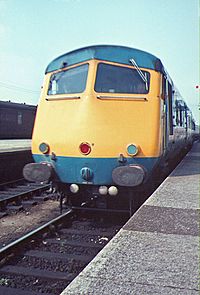British Rail Classes 251 and 261 facts for kids
Quick facts for kids British Rail Class 251 and 261"Blue Pullman" |
|
|---|---|

|
|
| In service | 1960 - 1973 |
| Manufacturer | Metropolitan-Cammell |
| Number built | 5 sets |
| Formation | 6 or 8 cars per set |
| Capacity | 132 (6 car) 228 (8 car) |
| Operator(s) | British Rail, Western Region and London Midland Region |
| Specifications | |
| Maximum speed | 90 mph (145 km/h) |
| Weight | 299 tons (6 car) 364 tons (8 car) |
| Prime mover(s) | NBL/MAN V12 Supercharged |
The Blue Pullman was a special luxury train in the United Kingdom. It ran from 1960 to 1973. These trains were different because they were the first high-speed diesel-electric trains. They were called "Blue Pullman" because of their unique blue color.
These trains were part of a plan to make train travel more exciting. They aimed to compete with cars and airplanes. Even though they didn't last long, the Blue Pullmans showed that fast, modern trains could work. They even helped inspire the famous InterCity 125 trains. Sadly, none of the Blue Pullman trains were saved after they stopped running.
Contents
What Was the Blue Pullman?
The Blue Pullman was a type of train designed for luxury travel. It offered a first-class experience for passengers. These trains were built by Metropolitan-Cammell. They were known for their sleek design and special features.
Why Were They Special?
The Blue Pullman trains were unique for several reasons:
- Diesel-Electric Power: Unlike older trains pulled by separate engines, these were "multiple units." This means each part of the train had its own power. They used diesel engines to make electricity, which then powered the wheels.
- Fixed Formation: The train cars were permanently connected. They were not usually uncoupled during service. This made them very stable and smooth for high speeds.
- Luxury Travel: They were designed for comfort. Passengers could enjoy fine dining and a very smooth ride. The goal was to make train travel feel special and modern.
Competing with Cars and Planes
In the 1950s, more people started using cars and flying. British Railways wanted to bring people back to trains. The Blue Pullman was their answer. It was meant to be a fast, stylish, and comfortable way to travel. This was part of the 1955 Modernisation Plan for the railways.
Where Did the Blue Pullman Run?
The Blue Pullman trains mainly ran on two important routes. These routes connected major cities in England and Wales.
Western Region Routes
One set of Blue Pullman trains ran on the Western Region. They connected London Paddington to cities like Bristol and South Wales.
- London to Bristol: This route connected the capital to the city of Bristol.
- London to South Wales: This route went from London to places like Cardiff and Swansea in South Wales.
Midland Region Routes
Another set of Blue Pullman trains operated on the London Midland Region. These trains connected London St Pancras to Manchester.
- London to Manchester: This service was known as the Midland Pullman. It offered a direct, fast link between these two big cities.
The End of the Blue Pullman
The Blue Pullman trains ran for about 13 years. They were taken out of service in 1973.
Why Did They Stop Running?
Several reasons led to their withdrawal:
- High Costs: The trains were expensive to run and maintain. Their special design meant they needed unique parts and care.
- Limited Use: They were only first-class trains. This meant they couldn't carry as many passengers as regular trains.
- Newer Trains: British Rail was developing new, more efficient trains. The InterCity 125 was one such train. It offered similar high speeds but was more flexible.
Their Legacy
Even though the Blue Pullmans were not a huge success, they left an important mark. They proved that fixed-formation, high-speed trains could work in Britain. This idea was later used to create the very successful InterCity 125. The Blue Pullmans were a step towards modern, fast train travel in the UK.
Images for kids
-
The Midland Pullman at Cheadle Heath before its regular non-stop morning run to London St Pancras on 28 September 1960
-
Eight-car Bristol Pullman set arriving at Bristol Temple Meads on 5 May 1973 (the final day of operation).
-
A Blue Pullman in the original blue and white livery at Bath in 1966









